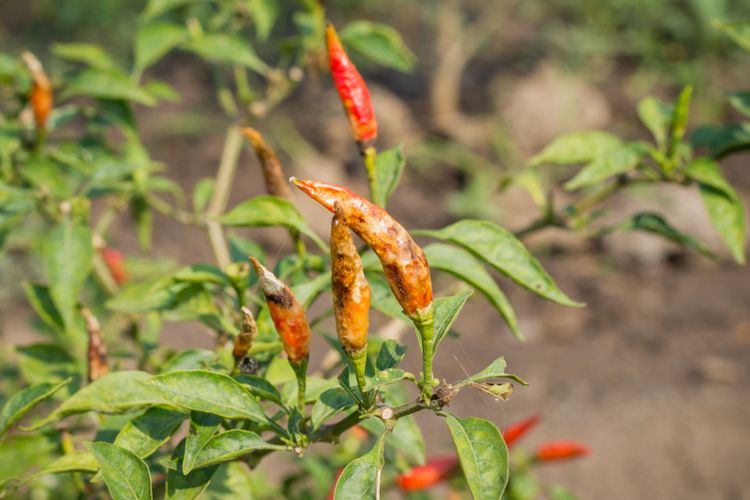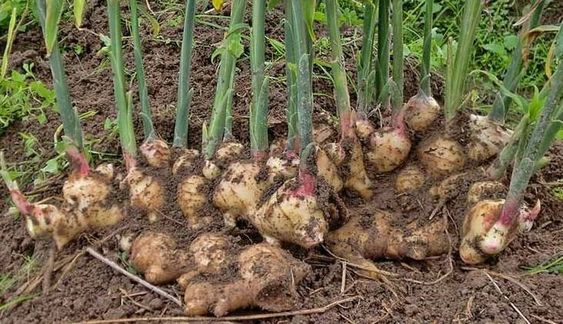Managing Fungal Diseases in Chili Plants
Fungal Diseases are one of the most common and damaging threats to chili plants (Capsicum spp.), significantly reducing crop yield and quality. These infections manifest in various forms, including leaf spots, fruit rot, and seedling collapse. This article will delve into the causes of fungal infections in chili plants, the factors that promote their spread, and effective ways to overcome and manage these diseases to ensure healthy and productive crops.
Contents
1. Common Fungal Diseases in Chili Plants
- Anthracnose (Colletotrichum spp.): Anthracnose is a widespread fungal disease that affects both leaves and fruits, causing dark sunken lesions on the fruits. It thrives in warm, humid climates and spreads rapidly through water splash, infected plant debris, and seeds.
- Powdery Mildew (Leveillula taurica): Powdery mildew is characterized by white, powdery fungal growth on the surface of leaves. It primarily affects the upper surface, leading to chlorosis (yellowing) and necrosis (death) of plant tissues.
- Damping-Off (Pythium spp. and Phytophthora spp.): Damping-off is a disease of seedlings caused by soil-borne fungi. It results in seedling death, especially in waterlogged or poorly drained soils. The fungi infect the root system, leading to root rot and eventual collapse of the seedling.
- Fusarium Wilt (Fusarium oxysporum f. sp. capsici): Fusarium wilt is a soil-borne fungus that attacks the vascular system of the plant, restricting the flow of water and nutrients. It causes wilting, yellowing of leaves, and eventually the death of the plant.
2. Factors Promoting Fungal Infections in Chili Plants
Several environmental, biological, and agronomic factors contribute to the spread and severity of fungal infections in chili plants.
2.1 Environmental Factors
- Humidity and Rainfall: Fungi thrive in moist environments, and high humidity provides the ideal conditions for fungal spores to germinate and infect plants. Frequent rainfall or over-irrigation further exacerbates the spread of fungal diseases as spores are often disseminated by water splash.
- Temperature: Warm temperatures, especially between 25°C and 30°C, favor the growth and reproduction of many fungal pathogens, such as Colletotrichum (Anthracnose) and Fusarium spp. Rapid changes in temperature can also stress plants, weakening their defense mechanisms against fungal attacks.
- Poor Air Circulation: Crowded planting or lack of proper spacing between plants creates a microenvironment of high humidity and poor air circulation. This condition facilitates the growth of fungi, especially on the underside of leaves.
2.2 Agronomic Factors
- Overwatering: Excessive irrigation or poor drainage in fields can lead to waterlogged soils, which is a conducive environment for root rot fungi like Phytophthora and Pythium spp. Constantly wet conditions weaken plants and make them more susceptible to infections.
- Soil Contamination: Fungal pathogens can survive in the soil for long periods, especially if infected plant debris is not properly removed. Contaminated soil can be a persistent source of infection, especially for soil-borne diseases like Fusarium wilt.
- Use of Contaminated Seeds: Some fungal pathogens, such as Colletotrichum (Anthracnose), can be seed-borne. Planting infected seeds results in disease outbreaks that may devastate the crop.
- Overuse of Nitrogen Fertilizers: Excessive use of nitrogen fertilizers encourages lush, tender growth, which is more susceptible to fungal infections. Balanced fertilization is essential to avoid excessive vegetative growth that fungi exploit.
2.3 Biological Factors
- Presence of Insect Vectors: Some insects, such as aphids and thrips, can serve as vectors for fungal diseases, spreading spores from one plant to another. They create wounds on the plant surface, providing entry points for fungal pathogens.
- Weakened Plant Immunity: Plants under stress from nutrient deficiencies, improper watering, or environmental changes are more vulnerable to infections. A weakened immune system reduces the plant’s ability to fend off fungi effectively.
3. Symptoms and Identification of Fungal Diseases
- Anthracnose Symptoms: Symptoms of anthracnose include dark, sunken lesions on fruits, which may later turn into concentric rings of fungal growth. The affected fruits often drop prematurely, leading to significant yield loss.
- Powdery Mildew Symptoms: Powdery mildew appears as a white, powder-like growth on the upper surface of leaves, leading to yellowing and curling of leaves. Severely infected plants have stunted growth and reduced fruit quality.
- Damping-Off Symptoms: Seedlings infected with damping-off fungi typically show wilting and stem collapse at the soil line. Roots may appear black and rotten, and the seedling may fail to emerge entirely in severe cases.
- Fusarium Wilt Symptoms: Fusarium wilt is characterized by one-sided wilting of leaves, yellowing of the lower leaves, and eventual browning and death of the plant. When cut open, the stem shows browning of the vascular tissue.
4. Strategies to Overcome Fungal Diseases in Chili Plants
Managing fungal infections in chili plants involves a combination of cultural, biological, and chemical practices. Implementing these strategies helps in reducing the severity of infections and minimizing crop losses.
4.1 Cultural Practices
- Crop Rotation: Crop rotation is an essential cultural practice to break the life cycle of soil-borne fungal pathogens. Avoid planting chili or other solanaceous crops (e.g., tomatoes, eggplants) in the same field for consecutive seasons.
- Proper Spacing and Pruning: Adequate spacing between plants improves air circulation, reducing the humid conditions that promote fungal growth. Pruning lower leaves and branches can also prevent the spread of soil-borne fungi to the upper parts of the plant.
- Irrigation Management: Drip irrigation systems are preferable over overhead watering, as they reduce water splash that spreads fungal spores. Avoid over-irrigation, especially in poorly drained soils, to minimize root rot diseases.
- Sanitation and Field Hygiene: Removing infected plant debris, fallen fruits, and weeds from the field reduces the inoculum source for future infections. Cleaning tools and equipment also helps prevent the spread of fungal pathogens.
4.2 Biological Control
- Use of Beneficial Microorganisms: Some beneficial fungi and bacteria can suppress pathogenic fungi by competing for resources, producing antagonistic compounds, or parasitizing the pathogens. Trichoderma spp. and Bacillus subtilis are commonly used biological agents against soil-borne fungi like Fusarium and Pythium spp.
- Resistance Breeding: Planting chili varieties that are resistant or tolerant to specific fungal diseases can significantly reduce the risk of infection. Seed companies and agricultural researchers are continuously working to develop disease-resistant chili cultivars.
4.3 Chemical Control
- Fungicides: Fungicides can be used as a preventive measure or to control the spread of fungal infections. Common fungicides for chili plants include copper-based compounds, sulfur, and synthetic fungicides like mancozeb, chlorothalonil, and difenoconazole. However, overreliance on fungicides can lead to the development of resistant fungal strains, so it should be integrated with other management practices.
- Seed Treatment: Treating seeds with fungicides before planting can help prevent the introduction of seed-borne fungal pathogens. Chemical or biological seed treatments offer protection during the early stages of plant growth, when seedlings are most vulnerable.
4.4 Integrated Pest Management (IPM)
A holistic approach like IPM combines various control methods to manage fungal infections sustainably. This approach includes monitoring disease incidence, using resistant varieties, implementing proper cultural practices, and applying fungicides judiciously when necessary.
5. Future Trends in Managing Fungal Diseases
Research in plant pathology is focusing on more sustainable and eco-friendly solutions to fungal diseases in crops like chili. Biocontrol agents, the use of plant growth-promoting rhizobacteria (PGPR), and advancements in molecular breeding techniques are paving the way for more effective and environmentally safe methods to manage fungal diseases. Precision agriculture tools like drones and satellite imagery are also helping farmers detect and respond to disease outbreaks early, reducing the need for excessive fungicide applications.
Fungal infections are a significant challenge for chili farmers, but with a comprehensive management strategy that includes cultural, biological, and chemical methods, the damage from these diseases can be minimized. Sustainable practices such as crop rotation, proper irrigation management, and the use of resistant varieties can go a long way in reducing the occurrence of fungal diseases. By integrating various control measures, farmers can ensure healthier plants, better yields, and a more sustainable farming system.
Sources:
- Agrios, G. N. (2005). Plant Pathology (5th Edition). Elsevier Academic Press.
- Gálvez, L., & Krauss, U. (2019). “Integrated Management of Anthracnose in Chili Pepper Crops”. Journal of Plant Protection Research, 59(2), 143–156.
- Bhale, U. N. (2015). “Fungal Diseases in Capsicum and Their Management”. International Journal of Agriculture Innovations and Research, 4(1), 72-80.
- Pappu, H. R., Jones, R. A. C., & Jain, R. K. (2009). “Global Status of Tospovirus Epidemics in Diverse Crops: Successes Achieved and Challenges Ahead”. Virus Research, 141(2), 219–236.




